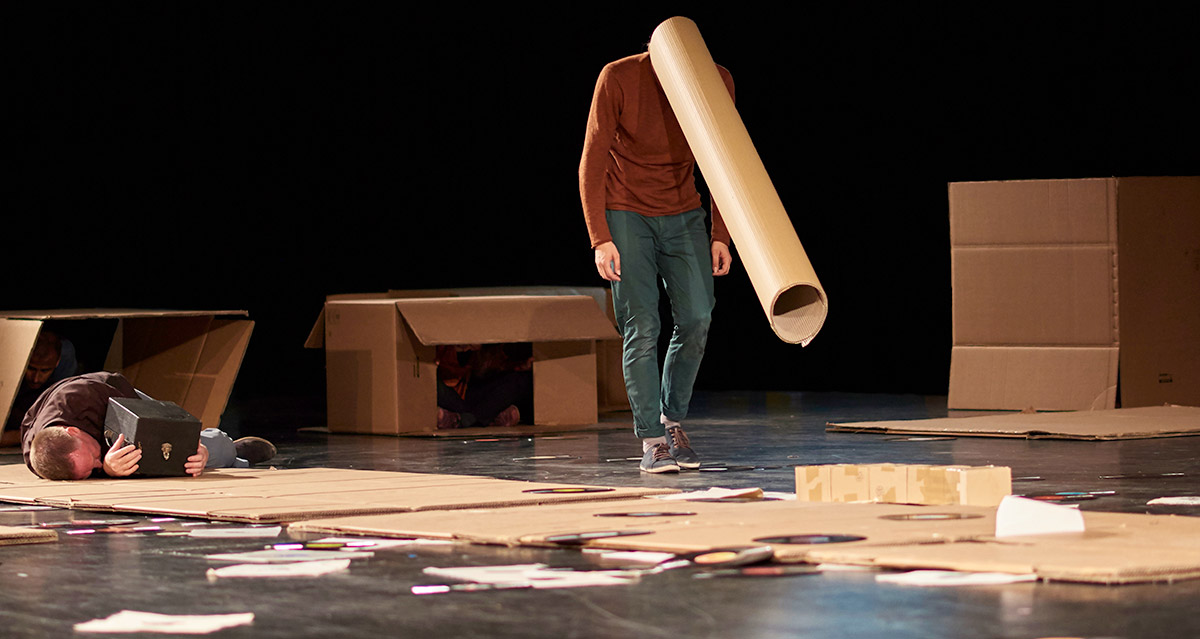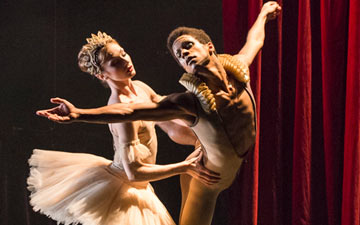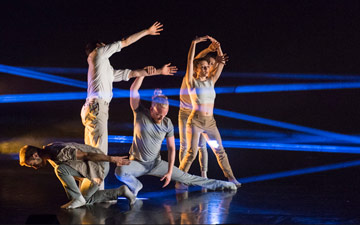
© Lee Carter. (Click image for larger version)
Tilted Productions
Constructions of Thin Air
★★★✰✰
London, The Place
tilted.org.uk
www.theplace.org.uk
The stage is bare, apart from some large, flat-packed cardboard boxes and vinyl records scattered around. Suddenly the performers walk on with business-like alacrity, carrying roles of paper and smaller boxes. It’s a hive of activity as they efficiently construct walls, tables, small dens and works stations. If only builders worked with such speed and dexterity.
As always with Maresa von Stockert’s choreography her new theatre piece, Constructions of Thin Air exposes her skill at working with objects, in making an installation out of cardboard which can then be taken apart in a second; or finding multiple uses for something as ordinary as a chair. Another of her strengths is in how she crafts imaginative physical material out of pedestrian actions such as walking, sitting, moving a table or folding a pair of trousers.
Constuctions of Thin Air is a fluid installation about change, home and belonging performed by a highly individual cast of nine intergenerational dancers. It’s divided into two parts with the first half suggesting work patterns and cycles of change. The architecture of boxes constantly shifts, depicting hubs where people work or live. Movement emerges through the manipulation of objects – principally records and boxes which are fitted together, stacked in piles or unfolded while the records are distributed, collected and discarded.

© Lee Carter. (Click image for larger version)
Some of the dancers form a factory line for sorting the records. There are several items that remind us of the past in this scenario: the black circular vinyl itself, a gramophone player and the production line formed by people instead of machinery. But this system breaks down as the performers move out of synch: one person (hidden inside a box) passes the records along too fast or the reciever at the end of the line isn’t there. Records cascade out of the corners of boxes and are thrown across the space in panicked response. In a crazy high-energy scene, the dancers occupying their own spaces, attach various objects to their bodies or wear them. Anders Duckworth transforms a dull sheet of brown paper into an elegant dress, Tuan Ly turns record sleeves into a toreador’s jacket. Lee Carter inhabits a large box and arranges shards of vinyl around the top – it makes no sense, this delightful slippage between prosaic, rational action into the totally wild and absurd.
The second half is more meditative and shows greater emotional contact between the performers who examine what home means and how we form our identities through the different modes of belonging. Now a whole room has been installed out of stacked boxes. The performers appear like an extended family, sifting through belongings, clearing out their home, in anticipation of a move. Here Stockert creates a sense of nostalgia through combining delicate fragments of movement material with personal possessions from the past. We see an entangled duet between Carter and Cecil Rowe who loosely embody the parents of the group. Then a deeply moving exchange between the youthful Duckworth and the older Rowe as they both sort through records, clothes and photographs, stopping and sharing together memories in a fleeting moment of unity. Tuan Ly walks on listening to a small tape-recorder playing a mother’s voice wishing her son a happy birthday. Poignant references to absence.
Crackling sounds from scratchy recordings of piano music and vintage songs further intensify feelings of longing and reminiscence. As the space is emptied photographs litter the floor until they too are swept aside. Faint traces of pasts linger in movement and object, but not for long.
Other couples come and go through the emptying room in a fragmented jigsaw of stories, dragging each other like objects or embracing each other tenderly until action builds to a wild crescendo and they dismantle the wall of boxes. Von Stockert doesn’t do sentimental and with fresh determination and practicality, the dancers reassemble the boxes to create new walls and dens.
Von Stockert fabricates choreographic material as inventively as she does material objects. Interweaving metaphor and motion which convey subtle shades of meaning , her work avoids stagnation or sentimentality with its down to earth practicality and strong physical presences. Constructions of Air evocatively suggests our relationship with the past, our own histories, memories and how we make sense of change.

















You must be logged in to post a comment.